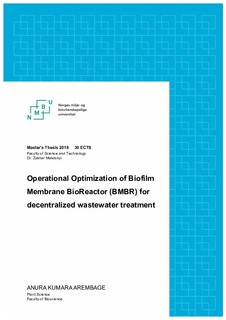| dc.description.abstract | Biofilm Membrane BioReactor (BMBR) is a promising technological combination of moving bed biofilm reactor (MBBR) with membrane bioreactor (MBR) for municipal and industrial wastewater treatment. It has resulted in prominent advantages over conventional methods, including treatment efficiency improvement, reduced footprint, better effluent quality, process intensification etc. However, membrane fouling acts as a huge barrier to extensive use of the technology and the only way that control the membrane fouling must be considered in designing BMBR which is optimization of treatment parameters. However in practical situations, these parameters vary from wastewater plant to plant based on membrane type, biological characters and type of wastewater etc. Therefore, optimizing the treatment parameters are essential to control membrane fouling that considers individual treatment plants rather than generalizing. To achieve this goal, current study was focused on two main sub-tasks: understanding and experimental determination of critical flux and comparison of membrane cleaning conditions. In addition, a problem of foaming in BMBR system has been investigated and inputs for system design optimization provided. The results showed that net flux production efficiency in filtration in the pilot plant increased by 20% after introducing the proposed critical flux determination protocol, which helps to optimize the treatment conditions. Fouling could be controlled by relaxation itself using the protocol under the working flux 24-26LMH in the experimental conditions. With increasing flux level to 28, 30LMH application of backwash is needed for better filtration. When considering the fouling removal using chemicals, application of both 0.1 – 0.5%NaOCl and 5% citric acid gives good results in removing both organic and inorganic foulants from membrane surface. Considering physical cleaning, the highest fouling removability was obtained by the physical treatment combination used with a backwash hammer. However the obtained results show that membrane modules require further construction improvements in order to be used under backwash hammer. Effectiveness and usage of ceramic membranes could be increased if the plastic connectors of the ceramic membrane could be made by a durable material that can endure aggressive conditions. It has been found that unbalance in F/M ratio highly affected foaming behaviour, which resulted in many challenging problems in the handling and filtration process. These challenges include contamination by overflow from the separation tank to the permeate tank, obscure level sensors and restricted visual observations etc. In order to avoid contamination to the permeate tank, the proposal is to fix separation walls between tanks.
Conclusively, increased net flux production efficiency of the current pilot plant can be reached as a collective plan when considering critical flux, better combination of physical and chemical cleaning and mitigating foaming under the current plant operational conditions. | nb_NO |

